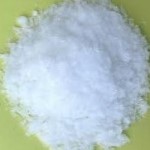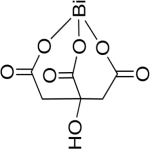CAS Number 813-93-4, Bismuth Citrate USP Grade Manufacturers Exporters







CAS Number 813-93-4, Bismuth Citrate Manufacturer Exporter
For Properties Specifications of Bismuth Citrate Click Properties, Specifications of Bismuth Citrate Manufacturer.
For Uses of Bismuth Citrate Click Uses of Bismuth Citrate Manufacturer.
For For SDS MSDS Sheet of Bismuth Citrate Click SDS Safety Data Sheet MSDS Sheet of Bismuth Citrate Manufacturer.
The Properties and Specifications of Bismuth Citrate:
Bismuth Citrate USP Grade Specifications
BiC6H5O7 398.08 -- CAS 813-93-4.
Bismuth Citrate contains not less than 49 percent and not more than 54 percent of bismuth (Bi).
Identification:
A: Infrared Absorption 197K : on the undried specimen.
B: When strongly heated, the salt chars, and on ignition leaves a more or less blackened residue having a yellow surface. The residue is soluble in warm nitric acid, and this solution, when dropped into a large excess of water, produces a white turbidity.
C: Dissolve 1 g in ammonia. When treated with hydrogen sulfide in excess, a black precipitate is obtained. Filter this mixture, drive off the excess hydrogen sulfide by heating, and allow to cool. To a portion of this cooled solution add an excess of calcium hydroxide and boil: a white precipitate is formed. Reserve a second portion of the cooled solution for the test for Limit of nitrate.
Arsenic: the limit is 10 microgm per g.
Limit of nitrate: To the second portion of cooled solution reserved from Identification test C, add an equal volume of sulfuric acid, mix, and allow to cool. Into the liquid, drop a crystal of ferrous sulfate, and allow to stand for 30 minutes: no brown or brownish black color appears around the crystal.
Limit of copper, lead, and silver: To pass the test; 10 microgm per g.
Limit of soluble bismuth: To pass the test.
The Uses of Bismuth Citrate:
Bismuth Citrate is used to treat peptic ulcer. It is used to treat occasional upset stomach, heartburn, and nausea. It is also used to treat diarrhea and help prevent travelers' diarrhea.
The MSDS-SDS Hazard Statement of Bismuth Citrate:
Bismuth Citrate SDS GHS, Safety Data Sheet
MSDS Sheet, Material Safety Data Sheet 05-Jan-23
1. Product Identification
Product Name & Other Names: Bismuth citrate.
CAS No.: 813-93-4
EINECS EC Number: 212-390-1
Molecular Weight: 398.08
Chemical Formula: [O2CCH2C(OH)(CO2)CH2CO2]Bi
Relevant uses and uses advised against (if any): Industrial use only.
2: Hazards Identification
GHS, Globally Harmonized System Classification in accordance with 29 CFR 1910
Classification according to Regulation (EC) No 1272/2008
Not a hazardous substance or mixture according to Regulation (EC) No. 1272/2008.
This substance is not classified as dangerous according to Directive 67/548/EEC.
Labeling according to GHS & Regulation (EC) No 1272/2008
GHS Label Elements NONE |
Signal Word: None
Precautionary statements:
P261: Avoid breathing dust/fume/gas/mist/vapors/spray.
P262: Do not get in eyes, on skin, or on clothing.
P281: Use personal protective equipment as required.
P302+P352: IF ON SKIN: Wash with plenty of soap and water.
P303+P361+P353 - IF ON SKIN (or hair): Remove/Take off immediately all contaminated clothing. Rinse skin with water/shower.
P304+P340: IF INHALED: Remove victim to fresh air and keep at rest in a position comfortable for breathing.
P305+P351+P338: IF IN EYES: Rinse cautiously with water for several minutes. Remove contact lenses, if present and easy to do. Continue rinsing.
P337+313: If eye irritation persists get medical advice/attention.
3. Composition/Information on Ingredients
Product Name & Other Names: Bismuth citrate.
CAS No.: 813-93-4
EINECS EC Number: 212-390-1
4. First Aid Measures
Always seek medical advice after the first aid treatment.
Skin: Wash exposed area with soap and water.
Eyes: Wash eyes with plenty of water for at least 15 minutes, lifting lids occasionally. Seek Medical Aid.
Inhalation: Remove to fresh air. If not breathing, give artificial respiration. If breathing is difficult, give oxygen.
Ingestion: If swallowed, induce vomiting immediately after giving two glasses of water. Never give anything by mouth to an unconscious person.
5. Fire Fighting Measures
Fire: It is not considered to be a fire hazard.
Fire Extinguishing Media: Use water spray, alcohol-resistant foam, dry chemical, or carbon dioxide. Use means suitable for extinguishing surrounding fire.
Special Information: In the event of a fire, wear full protective clothing and NIOSH-approved self-contained breathing apparatus with full face piece operated in the pressure demand or other positive pressure mode.
6. Accidental Release Measures
Personal precautions, protective equipment, and emergency procedures: Ventilate area of leak or spill. Avoid breathing dust/fumes/gas/mist/vapors/spray. Use individual protective equipment (waterproof boots, suitable protective clothing, safety glasses, etc.). Do not approach facing the wind. Do not touch the spilled material.
Environmental precautions: Do not let the product enter drains, soil, or water sources.
Methods and materials used for containment Cleanup procedures and Storage: Contain spilled material. Cover with an inert, non-combustible absorbent material, (e.g. sand, earth, diatomaceous earth, vermiculite). Vacuum or sweep-up and remove to an approved disposal container.
7. Handling and Storage
Precautions for safe handling: Apply according to good manufacturing and industrial hygiene practices. Ensure proper ventilation. In case of insufficient ventilation, wear suitable respiratory equipment. Wash thoroughly after handling. Do not drink, eat, or smoke while handling. Avoid contact with skin, eyes, and clothing. Minimize dust generation. Avoid breathing dust/fumes/gas/mist/vapors/spray. Keep container tightly closed. Avoid ingestion and inhalation. Use individual protective equipment (waterproof boots, suitable protective clothing, safety glasses, etc.).
Conditions for safe storage, including any incompatibilities: Store in cool, dry, and ventilated area away from heat sources and protected from sunlight in tightly closed original container. Keep air contact to a minimum. Store protected from heat, sparks and ignition sources and incompatible materials. Avoid contact with skin and eyes. Avoid inhalation of dust/mist/vapor. Do not store with incompatible materials like strong oxidizing agents.
8. Exposure Controls/Personal Protection
Engineering Controls: Use process enclosures, local exhaust ventilation, or other engineering controls to keep airborne levels below recommended exposure limits.
Exposure Limits:
No specific OES assigned, however for dusts of any kind, ensure LTEL (8-hour TWA ref. period) level does not exceed 10 mg.m3 for total inhalable dust or 4 mg.m3 for respirable dust (or) as recommended in current edition of EH40. Consult local authorities for acceptable exposure limits.
Ventilation System: A system of local and/or general exhaust is recommended to keep employee exposures as low as possible.
Personal Respirators (NIOSH Approved): For conditions of use where exposure to dust or mist is apparent and engineering controls are not feasible, a particulate respirator may be worn.
Skin Protection: Wear protective gloves and clean body-covering clothing.
Eye Protection: Use chemical safety goggles and/or full face shield where dusting or splashing of solutions is possible. Maintain eye wash fountain and quick-drench facilities in work area.
Other Control Measures: Maintain good housekeeping in work area. Handle in accordance with good industrial hygiene and safety practice. Wash hands after handling.
9. Physical and Chemical Properties
Appearance: It is white powder.
Odor: Odorless.
Odor threshold: Not available.
pH: Not available.
Relative density: Not available.
Melting Point: 300C - lit.
Initial boiling point and boiling range: Not available.
Flash point: Not available.
Auto-ignition temperature: Not available.
Decomposition temperature: Not available.
Upper/lower flammability or explosive limits: Not available.
Vapor pressure: Not available.
Vapor density: Not available.
Evaporation rate: Not available.
Flammability (solid, gas): Not available.
Partition coefficient: n-octanol/water: Not available.
Solubility(ies): Not available.
Viscosity: Not available.
10. Stability and Reactivity
Stability: It is stable under ordinary conditions of use and storage.
Hazardous Decomposition Products: When heated to decomposition, emits bismuth oxide, fumes and liberates carbon oxides.
Hazardous Polymerization: Will not occur.
Incompatibilities: Oxidizing agents.
Conditions to Avoid: Heat, incompatibles.
11. Toxicological Information
Acute toxicity: Not available.
Carcinogenicity: No component of this product present at levels greater than or equal to 0.1% is identified as probable, possible, or confirmed human carcinogen by IARC, ACGIH, OSHA and NTP.
Mutagenic Effects: Not available.
Developmental Toxicity: Not available.
Reproductive Effects: No information available.
12. Ecological Information
Environmental Toxicity: No information found.
Persistence and Degradability: No information available.
Mobility: No information available.
Bioaccumulation/ Accumulation: No information available.
Results of PBT and vPvB assessment: No data available for assessment.
13. Disposal Considerations
Whatever cannot be saved for recovery or recycling should be managed in an appropriate and approved waste disposal facility.
14. Transport Information
DOT USA & ADR/RID Europe: Not controlled.
IMDG: Not controlled.
IATA: Not controlled.
15. Regulatory Information
USA Regulations:
SARA 311/312 Hazards: No SARA Hazards. See section 2.
California Proposition 65: This product does not contain any Proposition 65 chemicals
Disclaimer:
****************************
Our company provides this MSDS sheet in good faith but makes no representation as to its comprehensiveness or accuracy. This SDS sheet is intended only as a guide to the appropriate precautionary handling of the material by a properly trained person using this product. The above information has been compiled from various sources and has the possibility of discrepancy and being out-dated information. Individuals receiving the information must exercise their independent judgment and do further search in determining its appropriateness for a particular purpose. In no case shall our company be liable to loss or damages by the product user.
****************************
Anmol Chemicals & Pharmaceuticals Pvt. Ltd. is an off-shoot of Anmol Chemicals Taloja. It is located in MIDC Taloja and it is manufacturing pharmaceutical grades of API, Excepients, Food grade and Reagent grade chemicals. Anmol Chemicals & Pharmaceuticals Pvt. Ltd. is a several decades old group of companies, engaged in manufacturing, supplying, distributing, wholesale supplies for actual users, retail or small pack supplies for research and development chemicals, fine and speciality chemicals, pharmaceutical excipients, mineral fortifiers in chemically pure, Analytical reagent grade, IP BP USP Ph Eur EP JP and other pharmaceutical grade monograph including FCC Food grade chemicals and Nutraceuticals, Mineral Fortifiers at best prices.

Bismuth Citrate Structure
CAS Number 813-93-4, Bismuth Citrate Manufacturer Exporter
ANMOL CHEMICALS & PHARMACEUTICALS Pvt. Ltd.
India, USA, Europe, UAE
TELEPHONE: +912223770100
Navi Mumbai, INDIA
e-mail: info(At the rate i.e. @)anmol.org
Copyright. 15-nov-24
We manufacture:
Glacial Acetic Acid Manufacturer

